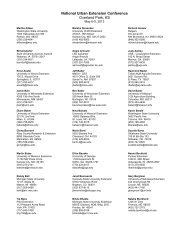Red cedar revetments for bank stabilization
Red cedar revetments for bank stabilization
Red cedar revetments for bank stabilization
Create successful ePaper yourself
Turn your PDF publications into a flip-book with our unique Google optimized e-Paper software.
Cedar Revetments <strong>for</strong> Bank<br />
Stabilization<br />
Dr. Charles Barden<br />
K-State Research and Extension
What are <strong>cedar</strong> <strong>revetments</strong><br />
• Whole trees are cut and anchored<br />
horizontally at the base of a stream <strong>bank</strong>.<br />
• Usually willow stakes or other seedlings<br />
are planted along with the anchored<br />
<strong>cedar</strong>.
ISU
Where will <strong>cedar</strong> <strong>revetments</strong> work<br />
• On 1 st order perennial streams, or<br />
intermittent streams.<br />
• To slow down lateral migration of the<br />
stream<strong>bank</strong>, especially on bare vertical<br />
<strong>bank</strong>s, 10-15 feet high.<br />
• Especially effective on sediment laden<br />
streams.
How do <strong>cedar</strong> <strong>revetments</strong> work<br />
• The dense foliage and springy branches<br />
slow down and deflect current away from<br />
the <strong>bank</strong>.<br />
• Sediment is trapped in the crown of the<br />
horizontal <strong>cedar</strong>, allowing live vegetation<br />
to get established.<br />
• The durable trunk will last <strong>for</strong> many years,<br />
further protecting the <strong>bank</strong>.
Cedar <strong>revetments</strong><br />
• Installed in Jackson County on Crow Creek<br />
in 1999, and Little Soldier Creek in 2000.<br />
• Marshall County near Axtell in 2007.
Crow Creek Revetment<br />
Be<strong>for</strong>e
Crow Creek Revetment Installation
Crow Creek Revetment<br />
Setting Willow Posts
Crow Creek Revetment<br />
After 1 Month
Crow Creek Revetment<br />
After 1 ½ Months<br />
Sediment<br />
Trapped
Crow Creek Revetment<br />
After 2 Months—Willows Sprouting
Crow Creek Revetment<br />
After 4 Months
Crow Creek- 1 year later
Crow Creek- 6 years later
To refresh your memory<br />
Crow Creek Revetment- Be<strong>for</strong>e
Crow Creek June 2005<br />
at the same location,<br />
6 years after <strong>cedar</strong><br />
revetment was<br />
installed.<br />
Crow Creek Feb. 1999,<br />
be<strong>for</strong>e <strong>cedar</strong> revetment<br />
was installed.
Mitchell Revetment<br />
Be<strong>for</strong>e
Little Soldier Creek, 3-2000
Mitchell Revetment<br />
After
Mitchell Revetment- 5 years later
Little Soldier, 6-2005<br />
Sediment trapped in <strong>cedar</strong>s
Steps to take<br />
• Will stream<strong>bank</strong> <strong>stabilization</strong> help<br />
• Apply <strong>for</strong> a CoE stream<strong>bank</strong> <strong>stabilization</strong><br />
nationwide permit.<br />
• Secure materials and LABOR!<br />
• Install<br />
• Monitor
More on permits<br />
• CoE nationwide permit <strong>for</strong> stream<strong>bank</strong><br />
<strong>stabilization</strong>. Requires a sketch plan and<br />
description of project, but not an<br />
engineered drawing, if not shaping the<br />
<strong>bank</strong>.<br />
• KS Div. of Water Resources requires a<br />
permit <strong>for</strong> stream obstructions, but not <strong>for</strong><br />
temporary, biodegradable materials<br />
(<strong>cedar</strong>).
Materials<br />
• Duckbill anchors with 8-10’ of cable<br />
• Bushy pasture Eastern red<strong>cedar</strong>, 10-20’<br />
tall, >8” butt diameter<br />
• Gas-powered jackhammer
Smaller #68 are OK <strong>for</strong> hand driving with rebar and sledge<br />
Larger #88 are required to fit shank of Pionjar (jackhammer<br />
available from Glacial Hills RC&D)
Duckbill Anchors
Source <strong>for</strong> anchors
Axtell Revetment<br />
• Currently being monitored<br />
• Very high <strong>bank</strong> > 30 feet<br />
• Only protected lowest 6 feet, or 20%<br />
• Used available concrete slabs and rock to<br />
protect toe.<br />
• Planted willows at bottom and plums<br />
higher up.
December 2006- be<strong>for</strong>e treatment
Trapped sediment from high flows
Sloughing soil held by <strong>cedar</strong>s
Direct costs of DIY 300’ revetment<br />
• Cut and haul 30 fifteen foot <strong>cedar</strong>s 1 man-day = $100<br />
• 31 duckbill anchors @ 13.80 each = $430<br />
• 3 people 2 days to install 6 man-days = $600<br />
• Jackhammer rental @ $50 = $50<br />
• Supplies (waders, gloves, cable clamps, fuel etc)= $320<br />
TOTAL = $1,500<br />
Note: Does not include design costs, permit costs,<br />
or depreciation on vehicles or equipment
To learn more<br />
• KFS website riparian<br />
<strong>for</strong>estry, revetment.<br />
• Missouri Dept. of Conservation website<br />
• search “tree revetment” has a<br />
good factsheet.
















